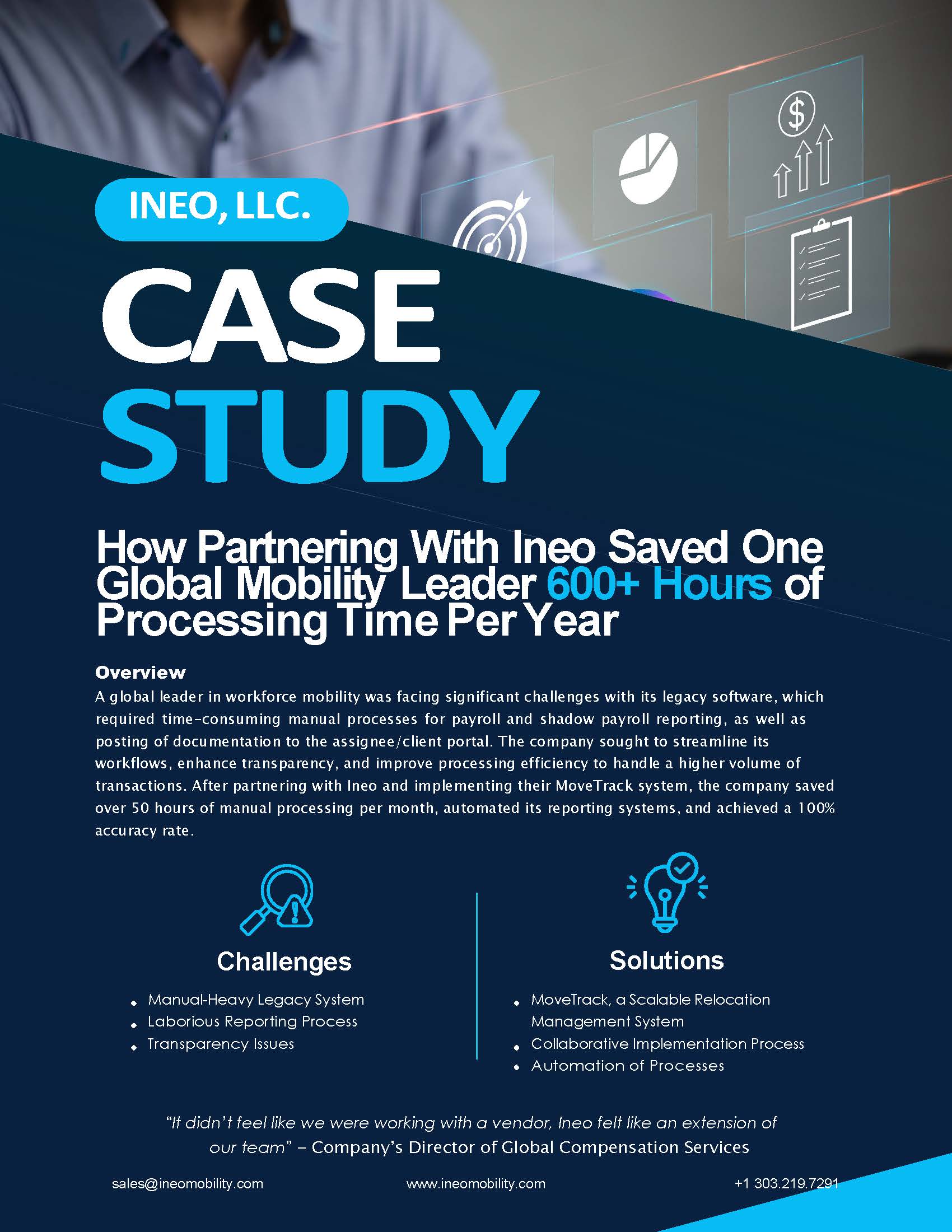Lump Sum Reimbursements: The Pros, Cons & Management Tools

Could your global mobility program benefit from this widely used expense reimbursement method? We’ve got the pros and cons you need to know.
Lump sum reimbursements are becoming a popular relocation benefit approach provided to employees to cover relocation costs. While these programs became prevalent with domestic relocations over the past decade, companies increasingly use lump sums for international relocations. This recent shift is mainly due to lump sum reimbursement popularity among younger employees, the rising majority of the dispersed workforce.
Companies considering the lump sum approach for relocation expenses should carefully consider the implications on their program and employees. Is a lump sum reimbursement approach feasible for your mobility program’s budget? Will it alleviate or cause additional administrative burdens? Does it promote your company’s culture and employee experience?
There’s a lot to examine when you’re weighing the benefits of assuming a lump sum approach to reimbursements. Read on to gain the knowledge needed to make the best choice for your global mobility program.
What exactly is a “lump sum reimbursement”?
Lump sum reimbursements refer to a payment made to relocating employees to cover expenses accrued during relocation. Lump sum reimbursements are an aggregate fixed amount that the employer reports as wages. No accounting back to the employer is required, and employees may keep any unspent reimbursement money.
Examples of common relocation-related expenses covered by a lump sum payment include:
- Temporary living allowance
- Costs related to a home sale
- Necessary travel expenses
- The purchase of a vehicle in the assigned country
- The shipment of household goods
Lump sum reimbursements are made regardless of whether or not the expenses are considered tax-deductible for an employee. This reimbursement approach requires the transferee to take advantage of allowable state tax deductions by making appropriate adjustments to their state-adjusted gross income and reporting deductible expenses on the proper forms.
What are the benefits of a lump sum reimbursement approach?
There are definite benefits to utilizing a lump sum approach for employee relocation reimbursements. For employees, lump sum reimbursement provides flexibility in that they receive a single sum payment and then can decide how they prefer to manage their move. It can be administratively more straightforward for organizations to manage than tracking and reimbursing employees for expenses related to long-term assignments or permanent transfers.
For organizations, the primary benefits of lump sum reimbursements include a simpler workflow, fewer transactions to account for, and controlled relocation costs. Many administrative activities are more easily handled with lump sum reimbursements. Employers may appreciate not needing to manage the relocation process or keep track of the numerous expenses related to an assignment.
Another benefit to lump sum reimbursements is the ability to adhere to a more precise budget. An organization must create a carefully considered standardized policy for determining lump sum amounts to ensure budgets remain balanced. Any decisions involving your mobility program’s budget should aim to balance assignment costs, support relocating employees, and satisfy recruitment objectives. With lump sum reimbursements, your program will have a pre-determined benefit amount to factor into your mobility budget, making remaining within your budget allotments more manageable.
Lump sum reimbursement benefits are most effective when paired with professional global mobility professionals. Ineo’s compensation services include total cost estimations for global assignments, international permanent transfers, and domestic and short-term assignments. Our professional budget calculations and cost estimates consider the total cost of all policy benefits, including lump sum reimbursements.
Some mobility programs may prefer a fixed lump sum amount, while others may vary benefits based on employee rank, relocation destination, the size of an assignee’s family, etc. Our client-specific cost estimate policy configurations reflect the parameters for each benefit type. We also support client-authorized cost estimation preparation, so you’ll have one less administrative chore on your hands.
Are there downsides to using lump sum reimbursements?
There are pros and cons to almost every decision in business, and lump sum reimbursement policies are no exception. Here are a few examples to keep in mind as you consider transitioning your mobility program to a lump sum reimbursement approach.
It may create additional stress during a relocation
Relocating for an assignment involves an employee relocating their life, sometimes landing in an entirely new country. Utilizing a lump sum reimbursement approach effectively repositions most of the work managing the move to the employee, which may increase their stress level as they look to transition to a new location and role. If the employee is inexperienced in organizing an international move, it may increase the chance that some aspects of the relocation could go amiss.
It may negatively affect employee morale
Offering a lump sum reimbursement may be perceived as low effort on the part of a company. If assignees are frustrated by carrying a heavier burden of the relocation logistics, they may feel undervalued. Lump sum reimbursements may give the impression that an organization puts the bottom line ahead of the interest of employees. In a post-pandemic world where hiring and retaining talent is more challenging than ever, a lump sum approach may appear less enticing than competitors’ relocation packages.
It may fail to cover the entirety of the relocation
One of the most significant risks of adopting a lump sum reimbursement approach is financial. Undertaking a relocation can be a complex process vulnerable to cost underestimation. With quickly fluctuating prices in a post-pandemic world still racked by supply chain issues and overall inflationary pressures, failing to account for unstable prices could cost the employee more than the lump sum reimbursement.
Because imprecise estimations may be made due to outdated, inaccurate historical data, ensuring your mobility program has the most recent information is essential in avoiding over or underpaying lump sum benefits. Ineo’s LumpSum calculator combines millions of current statistical records from the federal government with web-based research and standard data sources, providing estimation accuracy. With precise lump sum calculations, you remain within your budget and skirt missing the reimbursement mark.
It may have impactful tax consequences for employees
Because lump sum reimbursements are considered taxable income, assignees will experience additional tax liabilities. In some cases, depending on the size of the reimbursement, a lump sum payment could nudge assignees into a higher tax bracket. An increased tax bracket status may have less than ideal implications; for example, jumping into a higher tax bracket could impact financial aid calculations for employees with college-bound kids.
When you’re armed with the necessary tax knowledge, you can avoid startling assignees with unintentional tax liability differences. Ineo offers complete global mobility compensation services, which include accurate cost estimation, budget calculations, and ongoing administration. As your trusted financial solution provider, we partner with you to source data to help automate benefit and lump sum calculations, so you’ll always have accurate and transparent taxation details to relay to assignees.
Ineo’s LumpSum Calculator means accurate estimations, every time
Intuitive, easy-to-access, and extremely flexible, our cost-effective LumpSum Calculator reduces the administrative burden of processing reimbursements and empowers employees with the speed and independence they desire to support their mobility program’s needs.
Our policy-driven LumpSum Calculator contains comprehensive, updated GSA/CONUS data which allows for accurate estimations such as:
- Temporary living costs
- Final move costs
- Fare and rental car cost data
- Precise lodging rates
- Meal per diem rates
- Flying and driving mileage calculations
Ineo’s LumpSum Calculator is policy-driven, contains flexible reporting options, and can be run by itself or as an integrated module within our celebrated MoveTrack™ mobility software. We’ve created an interface that’s effortless to use without sacrificing accuracy, so you can focus on supporting your mobility program instead of being weighed down by error-prone administrative tasks.
Contact Ineo today to discover how our global mobility software, including our LumpSum Calculator, and comprehensive financial services can benefit your global mobility program.
Global Mobility Resources
Learn more about what’s going on at Ineo and insights into the complex world of global mobility from the industry’s top thought leaders and innovators.
Request A Demo
Whether you are new to the world of global mobility or you’ve been in the business for a while, Ineo is here to assist you.
The best way to learn how Ineo’s global mobility software can help your company revolutionize your global mobility program and support your business strategy is to see it in a demo.
Fill out this form to get started today.
Get Started

